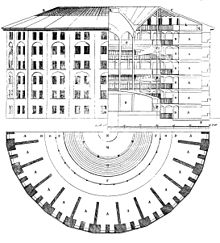
Back بانوبتيكون Arabic Panoptikum Azerbaijani Паноптыкон Byelorussian Panòptic Catalan Panoptikon Czech Panoptisk fængsel Danish Panopticon German Panopticon Greek Panóptico Spanish Panoptikum Estonian

The panopticon is a design of institutional building with an inbuilt system of control, originated by the English philosopher and social theorist Jeremy Bentham in the 18th century. The concept is to allow all prisoners of an institution to be observed by a single corrections officer, without the inmates knowing whether or not they are being watched.
Although it is physically impossible for the single guard to observe all the inmates' cells at once, the fact that the inmates cannot know when they are being watched motivates them to act as though they are all being watched at all times. They are effectively compelled to self-regulation. The architecture consists of a rotunda with an inspection house at its centre. From the centre, the manager or staff are able to watch the inmates. Bentham conceived the basic plan as being equally applicable to hospitals, schools, sanatoriums, and asylums. He devoted most of his efforts to developing a design for a panopticon prison, so the term now usually refers to that.